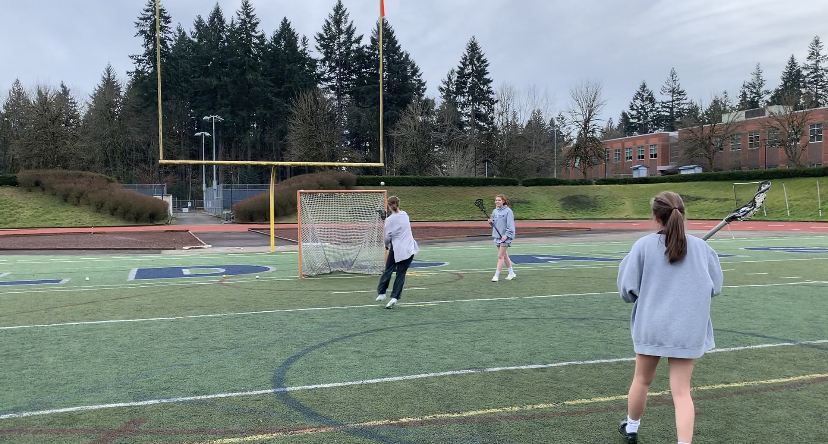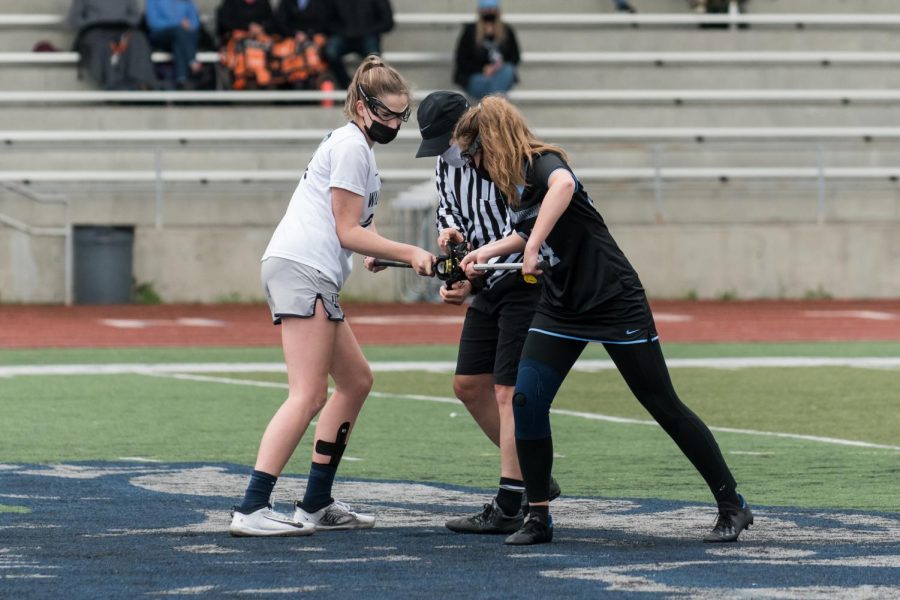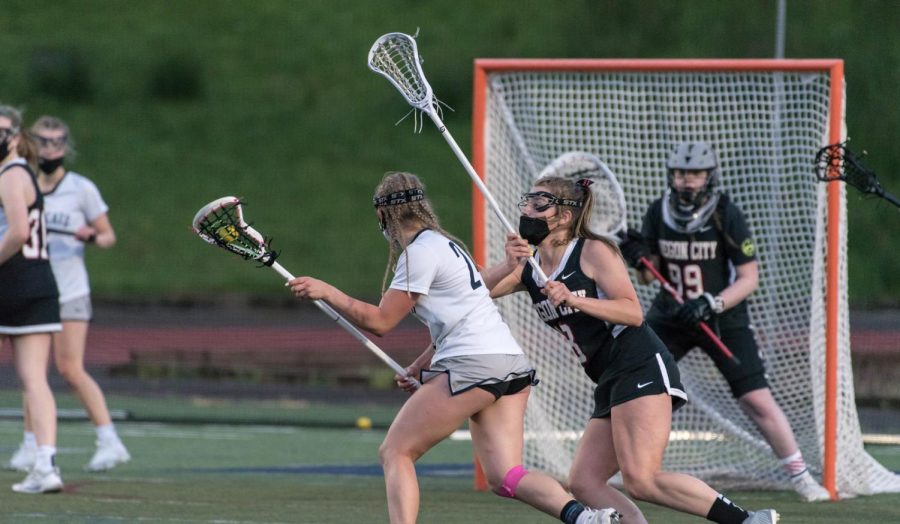Katelyn LeBlanc (far right) and Grace Jenson (far left) help Audrey Counts learn how to shoot. Counts is a freshman and prospective first year player for the team this coming season.
A fan’s guide to understanding WLAX
February 20, 2022
Girls lacrosse has one of the most confusing rulebooks of high school sports. My parents–who have watched me play the sport for seven years–still have no idea what’s going on a majority of the time.
After each game, they try to clarify what happened on different plays to cause the various foul calls: “What did it mean when the ref blew the whistle near the goal and waved her hand in front of her face?” or “Why did the ref swing his arm in a circle when you ran down the field?”
Grace Jenson, whose first year was her eighth grade season, is now a junior and plays attack for the Wilsonville girls lacrosse team. Jenson admitted, “There were a lot of rules in the beginning and it was confusing to learn at first, but everyone was super understanding and helpful. If I didn’t understand something, everyone would make an effort to help explain the rule.” Now headed into her fourth season, Jenson is fluent in the language of WLAX, and she even helped fellow junior Katelyn LeBlanc learn to play this past year.
In October of 2020, LeBlanc quite literally held a lacrosse stick for the very first time; however, six months later LeBlanc was not only comfortable on the field but a valued defender for the Cats: “It was really easy to feel overwhelmed at the start. There are definitely a lot of rules, but the coaches are also super understanding and put in a lot of time to teach the new players.”
If new players are so daunted by the rulebook, how are parents and fans ever expected to figure out what’s going on by purely watching the games? The answer is simple: you need to learn a few key components to the game, and the rest will come with time. Think of it as learning a new language–how are you supposed to become fluent if you don’t even know the alphabet?
So, as with anything, let’s start with the groundwork. Here is a basic overview of high school women’s lacrosse rules:
How is the field set-up?
The view from the stands during the Cats’ 2021 game against Oregon City/Clackamas. The Cats’ won the game 19-13.
The majority of high schools in Oregon play lacrosse on the main field, where football and soccer are also played; but in regards to lacrosse’s spatial set-up, there are a few key differences.
For one, lacrosse goals are not directly on the end lines; instead, they are placed almost like hockey goals where you can go behind the goal and stay in bounds.
Around the goal itself is a small circle called the “crease.” At younger levels, coaches tell their players it’s “hot lava.” If any player, excluding the goalie, crosses into the crease, it is an immediate foul and the other team’s ball.
Another important thing to note are the out-of-bounds rules. While the side lines function like soccer or basketball (meaning if your team throws it out of bounds, then it’s the other team’s ball), the end lines work a little differently: if a player shoots the ball and it flys off-target and out-of-bounds, it’s not automatically the other team’s ball.
Let’s say I shoot the ball, and it sails left of the goal and past the end-line. If one of my teammates is closest to the ball when it goes out, it’s still my team’s ball. When you are watching a game and see girls run to the end line with their sticks out, even when it’s obvious they can’t get to the ball–this rule is why.
Subbing is also different than in other sports like basketball, where the ref has to call you in. In lacrosse, you can sub during any live play or dead ball, which allows the game to flow more smoothly.
The game is played with twelve players on the field at a time: four attackers, three midfielders, four defenders, and one goalie. Live subbing allows teams to sub their midfielders regularly to keep their legs fresh and thus their transitions smooth.
This focus on a continuous game has built a fast-paced and competitive game that rarely ever stops.
What is a “draw”?
Maura Schramm, Class of 2021 alumni, takes the draw in the Cats’ final game agaisnt Mountainside. Schramm is now playing for Gerogia Tech’s club womens lacrosse team!
The first piece of the game to learn is called the “draw.” It happens at the start of each half and after each goal.
To set up for a draw, one midfielder is lined up on the midline, facing off against the opposing team’s midfielder. The remaining two midfielders are stationed at points around the circle depending on where they think the ball will fly after the ref’s whistle is blown.
The two players’ sticks are aligned parallel to the ground, and even with each other. The ball is sandwiched between the backs of their sticks. When the ref blows the whistle the draw-takers must push their sticks up and out; if the ball does not fly out above their shoulders, it results in a redraw. One important thing to note: the draw-takers must not move after the ref has set their sticks and begun to back away from them. If either player resituates themselves, or adjusts their grip, a foul is called, and the ball is given to the other team.
While the draw is being set up, the four defenders must stay behind their restraining line (usually the 30 yard line when played on a football field). The attackers stay behind their own restraining line on the mirrored side. However, when the ref swings an arm in a circle indicating possession has been won, they are able to advance up to the opposite restraining line (ex. An attacker can run all the way to the restraining line closest to their team’s goalie). This basically allows the attackers and defenders to travel two-thirds of the field.
During the 2021 season, Maura Schramm and Avery Lanz were the Cats’ usual draw-takers, switching off depending on the game situation. While Schramm’s draws were accurately placed and sent to the other two midfielders on the circle, Lanz’s specialties lay with self-drawing (meaning she controls the draw off of the draw herself).
I think it’s really fun.
— Alexis McIlmoil
Alexis McIlmoil, also a midfielder for the Cats, really enjoyed taking the draw, even if she wasn’t all that confident in it: “I think it’s really fun.” She went on to describe how it can be a point of stress during close games, and thus, “It was probably not the best to have me take it in dire situations.”
In many respects, the draw is an instrumental piece of the game: the more draws your midfielders control, the more opportunities you have to score and thus a higher likelihood of winning. If your team’s midfielders only control 25% of the draws, the opposing team consequently gets three times as many offensive possessions; and while these possessions don’t automatically lead to shots or goals scored, it puts considerably more stress on your defensive players.
Basically, the more draws your team wins, the better.
What are the most common penalties?
Tatum Hagen looks to score in the Cat’s 2021 league game agaisnt the Oregon City/Clackamas mixed team. Hagen was one of the Cats’ leading scorers. In the picture, you can identify the lack of help-side defense (like there would be in a basketball game) due to the shooting space rule.
Fouls are organized into two categories: minor fouls and major fouls. While minor fouls are problematic, major fouls can prove detrimental to a team’s chances of winning. Major fouls do not always result in a card, but all mandatory yellow cards are classified as major fouls.
Devyn Ratter, a junior attacker for WVHS, has been playing lacrosse for nine years. Ratter believes the most common foul called at the high school level is shooting space.
Shooting space occurs when an attacker goes to score (i.e. winds up, looks to shoot) and there is a defender between them and the goal. When the defender is farther than a stick’s length away (about a yard), the ref blows the whistle and the attacker is given a free-position shot on the 8-meter arc. A free-position shot’s equivalent is a penalty kick in soccer, or a free-throw in basketball.
Although, it is possible to successfully defend a free-position shot. There are hashes evenly spaced out along the 8-meter, and defenders are allowed to stand at the two adjacent to where the shooter is placed.
Along with being the most common foul, Ratter also believes shooting space to be the hardest foul not to get: “A lot of times newer players, or defenders, go toward the lane of where it’s going to be, not to the person.” If you know basketball concepts, a lacrosse defender playing split-line help defense is the fastest way to get a shooting space call.
Attackers can also try to draw the foul call by pump faking once they get into a plausible shooting position.
Carly Crocker, sophomore defender for WVHS, has been playing for seven years. Crocker disagrees with Ratter; she thinks that illegal checks are more prevalent. There are multiple types of illegal checks: empty stick check, across-the-body, in the sphere, etc.
An empty stick check usually results from larger numbers crowding the ball (ex. Instead of one or two players fighting for a ground ball, there’s five.) Specifically, an empty stick check is called “when someone is going to scoop the ball, and the ball isn’t in their netting or stick yet, and someone on the other team hits their stick–that’s an illegal check. The ball has to be in the stick.”
Across-the-body and in-the-sphere checks are called when a defensive player checks towards the player with the ball when they don’t have ideal positioning–or are out-of-control.
Other common fouls might include 3-second violations within the 8-meter, playing defense with your stick horizontal, and offsides; however, shooting space and illegal checks represent a majority of a WLAX game’s penalties.



